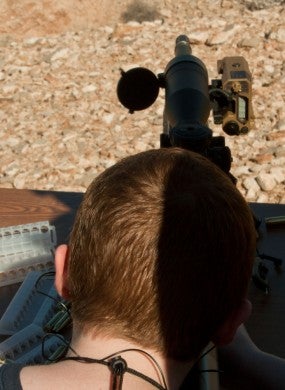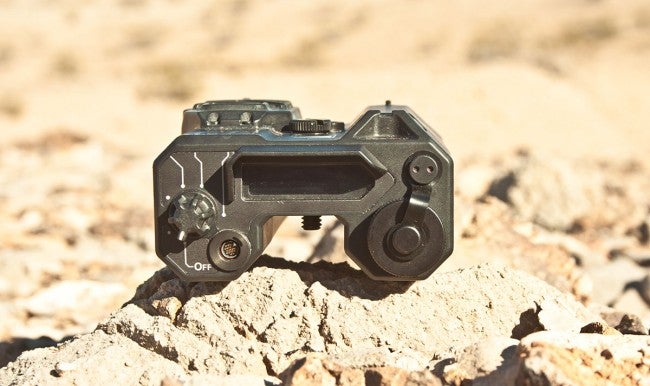We spent several hours out in the Las Vegas desert at the Metropolitan Police Dept’s range testing the new Wilcox Raptar.
The Raptar is a unique device that incorporates both visible and IR aiming lasers, an IR illuminator, and a laser range-finder. The integral laser range-finder is what really sets the Raptar apart from PEQ-15s and similar laser devices.
This unit was just starting to be available during the last half of 2013, but Wilcox is hoping to see it gain traction in the new year.
There are two modules to the Raptar that sit low on either side your picatinny rail. One side is the laser aiming module, the other is the rangefinder. In the center is a small LED display that provides ranging information. All the lasers are co-aligned, so once you have them zeroed you your scope or sights, you can direct the rangefinder component using your crosshairs.

While it might look large in photos, the Raptar is surprisingly light (10.8oz) and is designed to nestle behind the front sight base of an AR rifle. In this setup the iron sights are still available, and the lasers have a clear view of the target.

When making ballistics calculations for distant targets, the Raptar’s small shaded display gives you range output that you can feed into your scope or ballistics calculator. On close range targets, the red laser does what red lasers do best.
When using night vision systems, the IR laser and variable illuminator kick in, and the rangefinder’s display can be set to an IR out-put only.
It runs off a single CR123 battery, is available in black or tan, and includes a tape switch for remote activation of either laser system. This device covers all bases, and carries a $6,500 price tag as a result.
There is a rangefinder-less unit called the Raptar Lite that only includes the laser module; but I feel the integrated rangefinder is the most interesting differentiator. Out in the Nevada desert, I was able to ping 1400 yards without difficulty, in-line with the official 1500 meter capability.
Wilcox has taken things a step further, partnering with Applied Ballistics to bring us the Raptar M proto-type.
A substantial rework of the internal electronics means that Applied Ballistics found space for one of their chips inside the Raptar Chassis.
The M proto-type has a much more involved display screen (back-lit LCD rather than LED) and controls. But those enhanced controls mean that the unit now contains its own ballistics computer and weather chip to monitor atmospheric conditions.

The Raptar M’s rear display gives much more than just range. Instead it features:
- a virtual anti-cant device
- elevation information specific to your rifle load
- the ability to manually input windage
- the range itself
With that chip comes the ability to communicate via bluetooth via other Applied Ballistics devices to load new profiles onto your device.
An ambitious shooter should see the natural progression here: bluetooth synchonization between Applied Ballistics Kestrel unit’s and the Raptar M to provide live wind-data for a complete firing solution.
Its unclear whether that will be an option down the line, but it’s certainly on their minds.
With all this potential for growth and development, Wilcox has announcd that the Raptar will be fully upgrade-able to a Raptar M in the future. A purchase now can be converted later with a minimal upgrade fee.
With the rise of computer models and data in long-distance shooting, the Wilcox Raptar seems like a solid device for serious precision shooters.

 Your Privacy Choices
Your Privacy Choices
